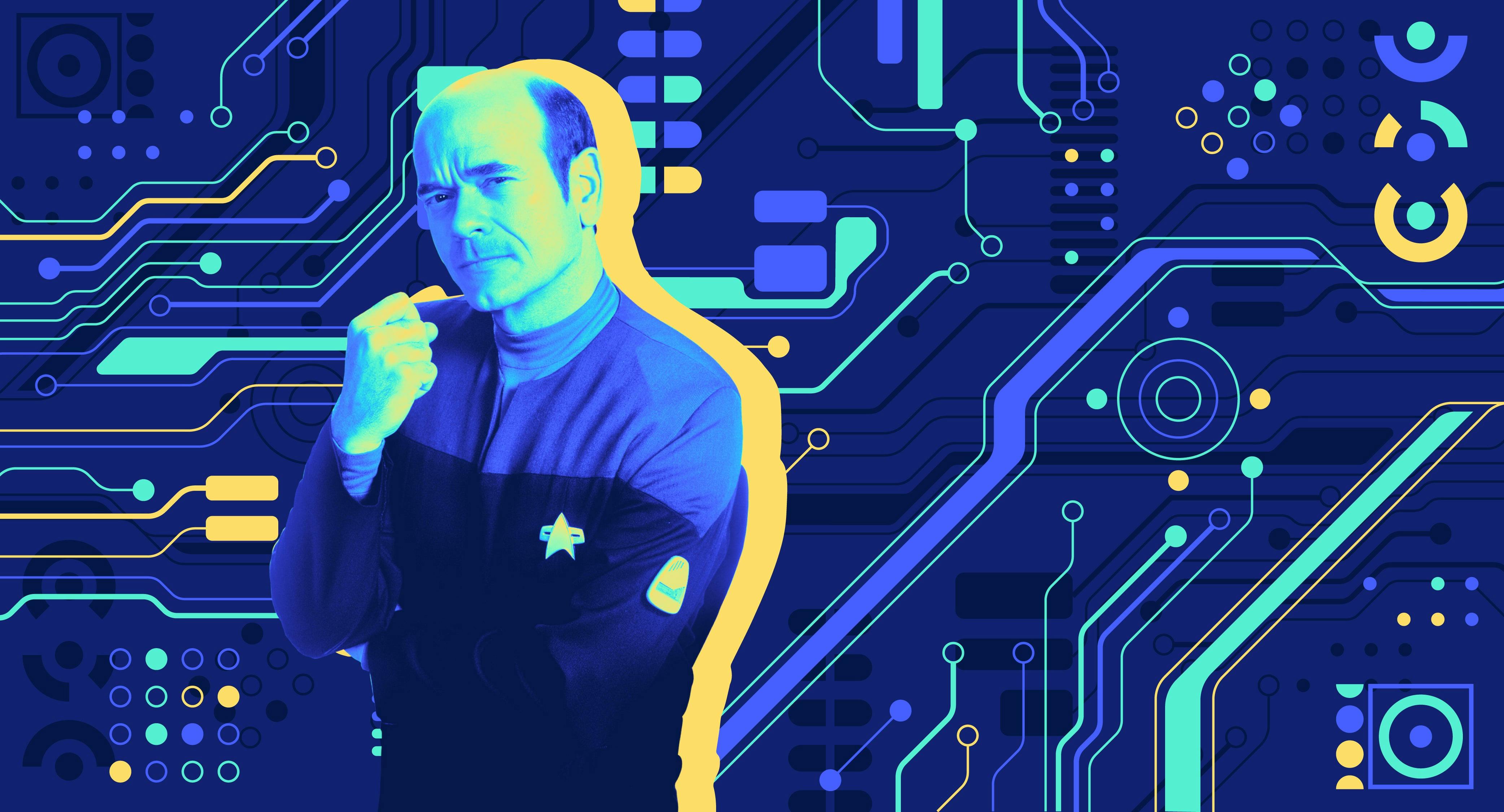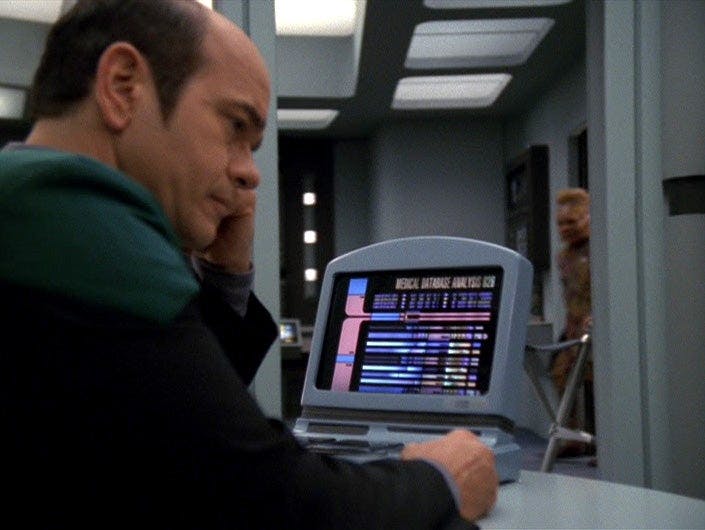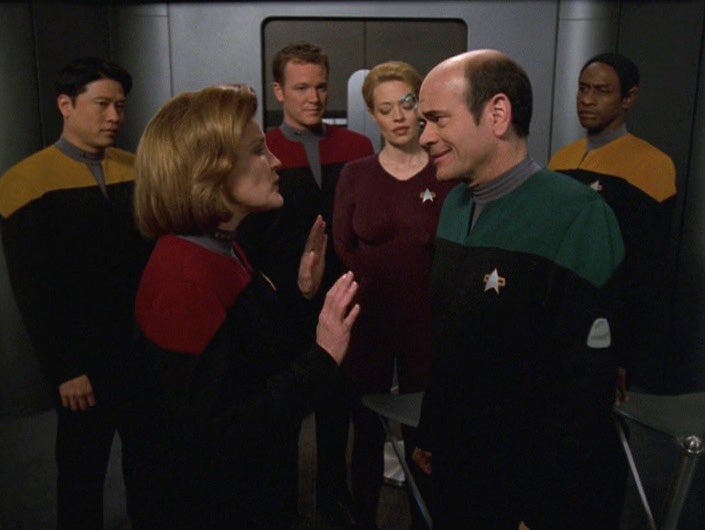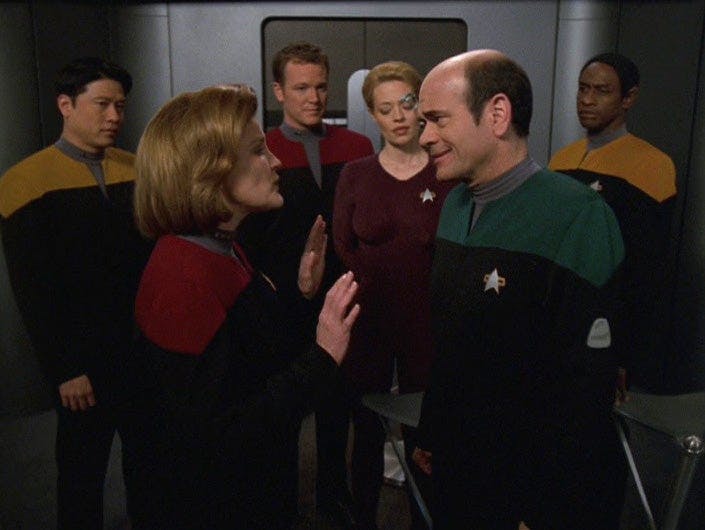Published Apr 18, 2023
'Author, Author' Can Teach Us A Lot About A.I. and Copyright
The episode uses the Doctor to explore what our future copyright laws could look like.

StarTrek.com
Scroll through Twitter and you may happen upon the I Forced a Bot meme. The premise goes something like this. "I forced a bot to watch 1,000 hours of Batman movies, and then asked it to write a Batman movie of its own." There are then a couple of photos in a script format that usually details a scene of deliciously bad writing that makes the audience laugh.
The meme goes on with Olive Garden commercials, Transformers, and Saw movies, amongst others, each time resulting in delightfully messy and yet entertaining bit that the internet collectively gobbled up. Yet, at this heart of this meme is the question of copyright and artificial intelligence. New computer programs used to assist artists in creating works of art involve not only initial data input, but also learning and transformative algorithms.
The trouble with the I Forced a Bot meme is that it isn’t just about the work generated by the supposed bot, but the work that the bot consumed to create the new work. In most cases and jurisdictions, in order to claim copyright, the work has to be original, and most definitions of originality require human authorship.

StarTrek.com
This quandary is perfectly encapsulated in the 2002 episode of Star Trek: Voyager entitled “Author, Author.” As the 20th episode of Voyager’s final season, “Author, Author” had a momentous question to ask surrounding the Voyager’s Doctor.
The Emergency Medical Holographic Program, or EMH, was first activated after Voyager’s run-in with The Caretaker, which led them to be stranded in the Delta Quadrant during the series' premiere. The newly activated hologram was abrasive and un-empathetic. Yet, over seven seasons, grew to not only understand the humans he was treating, but to appreciate his status as a hologram.
Still, Voyager’s mission was to return to Earth, and the closer they get, the more the question of what would happen to The Doctor comes to mind. Over the seasons, it was speculated that he’d be decompiled, or sent to work like the other decommissioned EMH Mark 1s.
In “Author, Author,” communication with Earth, the rest of the Alpha Quadrant, and with Starfleet, is reestablished. When The Doctor gets his turn to make a call home, he contacts a publisher regarding his holonovel loosely-based on his life. Although he makes it clear that what he sent was an early draft and later tries to halt publication, the Alpha Quadrant publisher refuses to respect his wishes because holograms don’t have the right to control their work. The last act of the episode, shows the crew rallying around The Doctor, demonstrating his humanity and arguing that he has the right to control his own work.
Star Trek: Voyager takes place in the 24th Century. We don’t have Emergency Medical Holograms, and computer programs aren’t sophisticated enough to generate their artistry on the same level as The Doctor, but watching “Author, Author” nearly two decades after it first aired, it is starting to feel like tech is inching closer and closer to this legal question.

StarTrek.com
There’s been no shortage of computer-generated art over the years. Computers have been generating crude versions of artwork, or assisting as tools to help artists in the creation of work since the 1970s. Today, machine learning and other algorithms means that computers can write or create the art themselves. Yet despite the prevalence of machines that learn and analyze a user’s behavior, copyright for machines is still out of reach.
In March 2019, the National Copyright Office updated the Compendium of U.S. Copyright Practices, 3rd Edition with the following text regarding claims to copyright, "The U.S. Copyright Office will refuse to register a claim in a work that is created through the operation of a machine or process without sufficient human interaction, even if the design is randomly generated."
The events of “Author, Author” perfectly illustrates what it would take for an A.I. to be given copyright over his work. When confronted with the legal reality that The Doctor has no rights because he’s a hologram, Captain Janeway says to him, “You have the same rights as every other member of this crew, and I am not going to let this publisher say otherwise.” The arguments that ensue all feed into the originality and artistry behind The Doctor’s holonovel. As viewers, we’ve seen him grow, we’ve watched him learn these new skills, and in the fishbowl of Voyager in the Delta Quadrant, he’s an equal. In the Alpha Quadrant, he’s just a piece of technology.
When the publisher compares The Doctor to a basic replicator, Tuvok replies, “I have never encountered a replicator that could compose music, or paint landscapes, or perform microsurgery.”

StarTrek.com
The Voyager crew eventually, all band together to illustrate exactly how The Doctor is just as human as any other member of the crew. Even though they aim big and attempt to get The Doctor declared a person, Starfleet isn’t prepared to go that far. Instead the arbitrator expands the legal definition of artist to include The Doctor, and orders all copies of the holonovel recalled immediately — the first step in the fight for holographic rights.
Back in the 21st Century, it looks like the first program to hold a copyright might not be that far off. The I Fed a Bot meme turned out to be fake, but the premise behind it is very real and continues to be used in computer programming. In 2017, 17-year-old high schooler Robbie Barrat developed a program that would develop rap lyrics based on 6,000 Kanye West lyrics. The neural network designed by Barrat at first only rearranged lyrics but eventually was eventually able to write new ones, with almost appropriate pauses in all the right places.
While the first medicine-practicing, opera-singing hologram hasn’t come along yet, it could be on its way, and the copyright questions these types of A.I. face, are not going to go away.
This article was originally published on January 28, 2020.
Lauren Busser (she/her) is a writer living in Connecticut and the Associate Editor at Tell-Tale TV. She is fascinated by the way humans interact with technology. Find her on Twitter at @LaurenBusser.
Stay tuned to StarTrek.com for more details! And be sure to follow @StarTrek on Facebook, Twitter, and Instagram.
